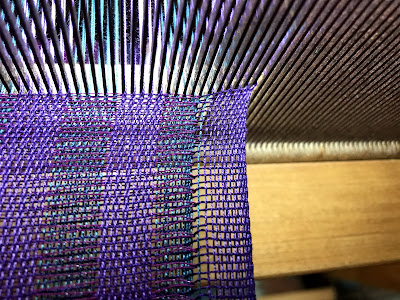I want to call this a "Midway Through the Month Mini-Post," because I typically write a blog post every month and this is the second one I've written in just a few days. But I have an important point to make....
Beating on an open shed: Let's discuss.
All my weaving life, until just a few months ago, I would beat the weft on a closed shed. It just seemed more snug and secure and that was the way I was taught.
Some background: Weaving is ambidextrous, right? Both hands throw the shuttle, both hands beat the beater. But people are not ambidextrous, typically. So, because I'm right-handed, my right selvages were never truly even, while my left selvages usually looked better. And the opposite holds true: Left-handed weavers usually do better on the right selvage, because for this they're catching the shuttle with their left hand and pulling the weft across nice and even and tidy.
(You might ask why, but think about it: For the right selvage, you throw the shuttle with your right hand and then catch the shuttle with your left hand, which tends to draw in on the right selvage.)
I tried a lot of different remedies, including holding the selvage in a pincer grasp as I closed the shed. Yes, that's right. It worked pretty well but it took a lot more time and effort. And then one day, when I was teaching a workshop, we got into a discussion about beating on an open or a closed shed. The weaver I was talking with insisted that she always beat on an open shed -- that this was the right way to do things.
So I tried it on my next warp. I have to admit it did not come naturally after 20 years of doing things the other way. But I kept trying. And then I took a look at my selvages. Lo and behold...
Take a look at the right-hand selvage (or selvedge) in the photo at the beginning of this post. The warp is 20/2 cotton, which calls for precision when it comes to the selvages. They look pretty good, right?
I'm not writing this to brag about my selvages; the point is to advocate for beating on an open shed. It stands to reason, when you think about it: An open shed allows the weft yarns to wiggle about more and snuggle into place as the beater places them against the fell line. I think of it sort of like the "bubbling" that tapestry weavers do before they beat the weft in. And I swear that, when I beat this way, I can even see the weft wind off the bobbin after I've thrown the shuttle, as the beater moves toward the fell line. (I tried to capture this in a video but it requires some really close camera work.)
Another advantage to beating on an open shed, which also stands to reason when you figure you're pulling less on your selvages: There is less draw-in of the fabric, which puts less stress on the yarns at the selvage. Here's a photo of how minimal the draw-in is on my warp:
Too much draw in is just plain tough on the fabric. Weaving is more about gentleness, in my view -- unless you're a rug weaver!
That's all for now. Thanks for reading.















